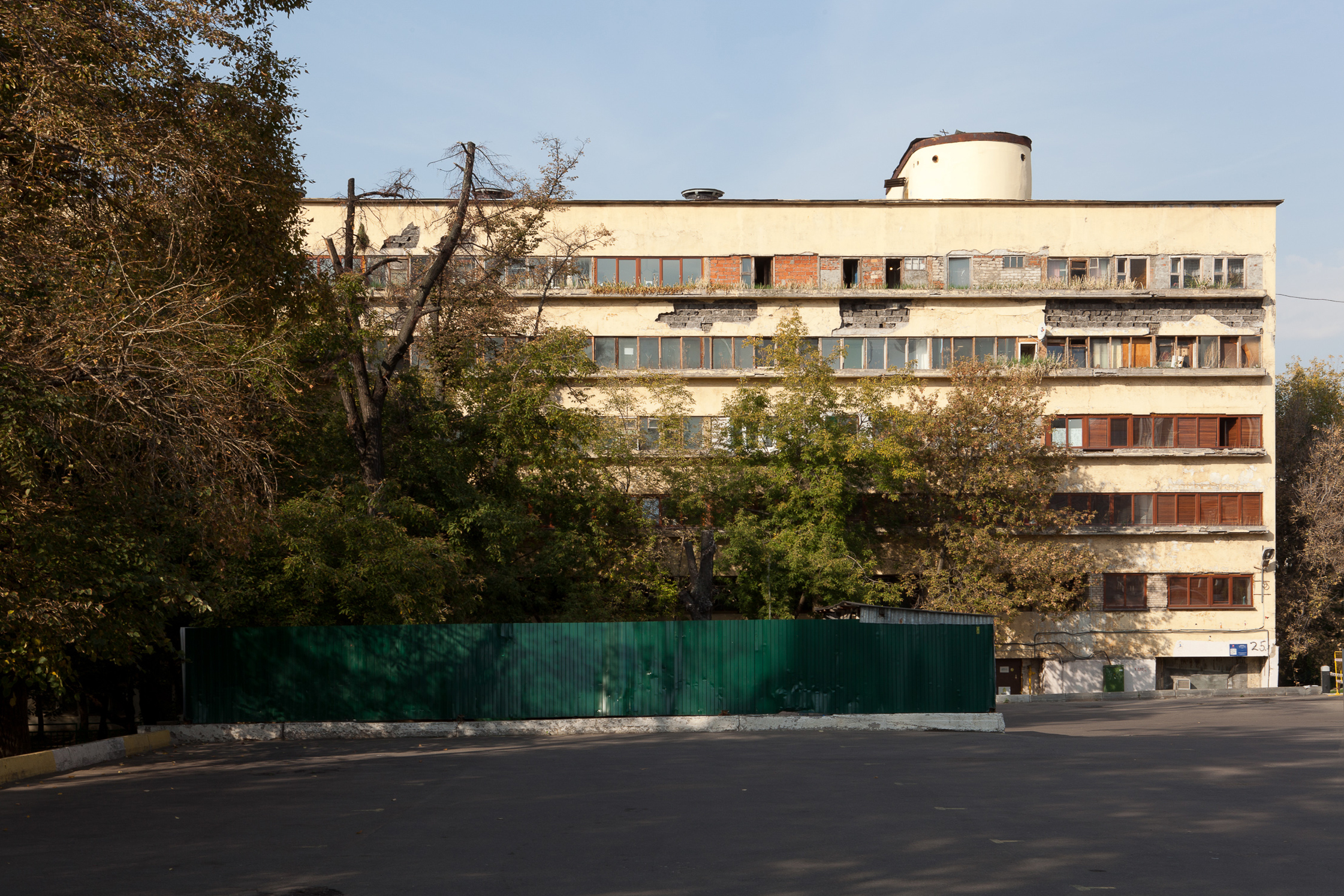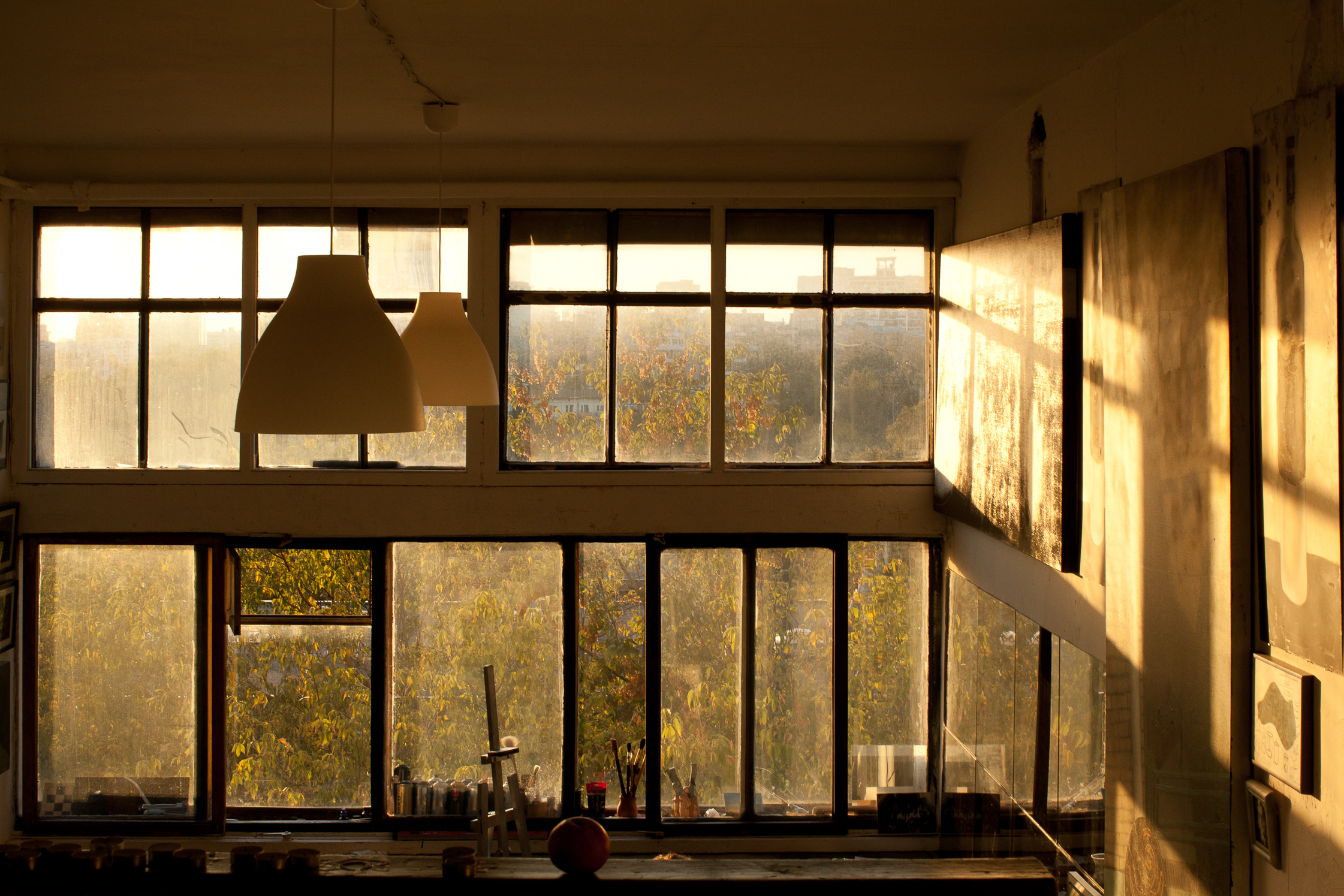For architecture lovers, the Narkomfin Building is a legendary place. Built in 1930 by constructivist architects Moisei Ginzburg and Ignatiy Milinis, it was seen in its early days as a symbol of a new way of life in Soviet Russia.
Divided into “cells,” the plain, rectangular building was initially intended as a home for people working at The People’s Commissariat of Finance. It represented the architects’ ideal vision of communal living, the thought being that residents would spend most of their days at work or in public spaces located inside the building. Long ago, it was also home to a famous Soviet painter, Alexander Deyneka, whose cell was bigger than most others; today, that space is empty and available for rent for parties and lectures.






In its modern incarnation, the building has become popular among artists, musicians and architects, who enjoy its frequent parties, film screenings and yoga classes. But the structure’s glory years are past, and it’s been in poor condition for a long time. Residents must deal with roof leaks and other problems. The studios are too small for good kitchens or bathtubs. However, it remains a space with great energy. What’s more, it’s home to many Russian creative professionals, including Anton Totibadze and Sasha Pasternak, painters – and great cooks – who met with us to discuss their lives and work over homemade bouillon.


-
Tell us about your studio in the Narkomfin Building. How did you find it? And what did it look like before you moved in?
Anton: We found it by accident. About a year ago, we were trying to find a work space through different websites and we stumbled upon this one. What can I say? It’s a good studio.
Sasha: When we moved in, we found the studio in poor condition. Frankly speaking, when I saw it, I was afraid towork here. There was a moldy smell; there was no light and no water. The walls were painted with different crazy colors. The ceiling was leaking. It still leaks sometimes in one place.
Anton: Anyway, it is our first studio. We renovated the space ourselves. We designed it, and found everything necessary for our work.




“We believe that our studio is a living organism. We have spent almost a year here, but no day is similar to another.”
-
How might you spend a typical day in the studio?
Anton: I always come in first.
Sasha: You don’t.
Anton: I do! We believe that our studio is a living organism. We have spent almost a year here, but no day is similar to another. People come or we stay here alone; some visit on business and others just for fun. People stop by in the morning, in the evening or when recovering from a hangover. We have parties, tidy up the room, work, watch TV, work again, break glasses. Sometimes neighbors call the cops. Paintings also constantly come and go, and we often hang them in different ways.
-
I know that you cook a lot and even hosted a series of dinners called “The Nourishing Days.” Can you tell us a bit about the idea behind that?
Anton: “The Nourishing Days” was an old idea that my friends and I had. We came up with it one day when we decided to cook for our own parties – we wanted to save people from boredom and alcohol poisoning. It usually followed one scheme: I gathered my mates and everyone chipped in, anywhere from 1,000 to 1,500 rubles, though expenses grew over the years. Then we went to Dorogomilovskiy Market, bought a lot of food and rushed at full speed to some lucky guy’s home. There, we would prepare a stunning meal, and everyone had something to do to keep busy. Every evening was shot on film, and then we edited a video. There were girls, music and dancing. All at once, all our friends wanted to attend. Then we grew up, became more busy and there was less time for parties. We found a new format for these events. Now “The Nourishing Days” has evolved into a series of events called “The Ball of Gluttony.” It’s more adult now – there is more food, fewer cameras.


-
How did you two meet?
Anton: Oh, it’s been a long time. We met six years ago, at one of “The Nourishing Days” events. In a nutshell, I was cooking and Sasha was eating.
Sasha: Actually, when I came to the party, there were almost nothing left.
-
What is your background? How did you start doing what you do now?
Sasha: My great-grandfather, Leonid Pasternak, was a painter – and my father, Boris Pasternak, is an architect. My brothers, my sister and I were all studying painting together – we visited one artist who taught us. But I was the only one who decided to pursue a career in art in the end. In 2007, I began to study set design at Moscow State Academic Art College of the Memory of 1905. Then in 2011, I started studying scenography at the Russian Academy of Theatre Arts, where I was lucky enough to be taught by a famous Russian artist, Natalia Nesterova.
Anton: My grandfather, Georgy Totibadze, was a Georgian painter and the head of the Tbilisi Academy of Arts, which was founded by my great-grandfather. My father and my uncle, painters Constantine and Gogi Totibadze, also studied there. I graduated from the Higher Academic School of Graphic Design here in Moscow, from Boris Trofimov’s workshop. I didn’t paint when I was a child – but one day I dipped into it very fast, and from there, I could not stop. Of course, design education helps me a lot in my work, but I don’t use a computer for it.

-
Sasha, you studied set design and worked at the Bolshoi Theatre. How did this affect your work?
Sasha: Well, now I’m studying scenography at the Russian Academy of Theatre Arts. And, of course, this affects my painting a lot. It has become more decorative and free thanks to the Academy. However, I think that having my own studio for painting changes my work even more. Now I’m not as involved in theater projects apart from working on my diploma which is related to set design. Although if I was offered an interesting project, I’d love to contribute.
-
What problems do encounter in your work life?
Anton: If you mean some kind of inner creative torment, then I have that very rarely. Basically, my problems are connected only with people’s greed, or the depreciation of the ruble against the the dollar and the euro in our country.
Sasha: Also, sometimes our roof leaks, and water drips from the ceiling.
-
Many young Russian artists complain that there is no developed market for contemporary art, and that causes a lot of problems. Do you agree?
Together: Yes! By the way, not only young artists complain about it, but gallerists and dealers, too.

“I don’t want to plan ahead. For now, I am painting and teaching art.”

-
Would you like to dedicate yourself to art completely?
Anton: I don’t know. That’s a difficult question. I just want to live a happy life. But, of course, I also want to be remembered after my death, and glorified for centuries by the entire planet. And I dream of opening a restaurant, a legendary one! (laughs)
Sasha: I don’t want to plan ahead. For now, I am painting and teaching art. I really like to work with children, to communicate with them.
-
Nowadays, many young creatives gravitate toward digital art over more traditional genres. Why did you choose painting?
Anton: Well, I paint, but I also do a lot other things. I shoot videos, make photographs, create etchings and linocuts, play accordion and piano, do archery, cook and sometimes work on graphic design projects. Recently, my friend offered to add neon lights to my paintings – so I’m constantly searching for something new.
Sasha: Painting is also not the only thing that I do. I make theater models and I like graphics, too. But I’m not on familiar terms with computers. So I can’t hope to work in the field of digital art, and I need to fill that gap. I’d also like to make sculptures, work as an architect, make engravings and pottery and also try to create jewelry.

-
What is it like to occupy such an historic building? How mindful are you of its past?
Anton: Honestly, we don’t think about the past of the building very often. Sometimes we remember it when one of our guests ask us something like, ‘Where was the bath supposed to be here?’
-
How do you think the space will continue to evolve with time?
Anton: It’s likely that soon the building will be completely renovated – but that’s not very good for us. It will mean that we have to leave our studio.












